Albarracin is an extremely popular bouldering destination in eastern Spain. Easily accessible, abundant in low to mid grade problems and with extremely reliable weather, the area is a fantastic alternative to Fontainebleau for a Spring or Autumn trip, as well as a decent winter venue. Unfortunately, it has also been a victim of its own success over the years and here more than anywhere else it is extremely important to follow basic rules when visiting the boulders.
The Area
Situated in Aragon, roughly half way between Zaragoza and Valencia, Albarracin is a small tourist town on the side of a hill, complete with a medieval wall, cathedral and twisted houses squeezed around narrow streets. This is an agricultural region, covered in rocky hills and boasting a rich history mixing Christian and Arab influences. The town and its surroundings lie at an altitude of roughly 1200m, providing them with dry weather and cooler temperatures than the coastal areas situated about two hours away.
In the middle of the limestone filled Sierra of Albarracin cuts a unique red sandstone canyon covered in dark green pine trees. This is the 'Pinares del Rodeno' protected natural area, which starts a few kilometres from Albarracin town centre. This area is home to the hundreds of boulders, so popular with climbers from Spain and the rest of the world.
The Climbing
The rock in Albarracin is a distinctive red sandstone, a little rougher than Fontainebleau's fine-grained white sandstone. It produces smooth surfaces, which seem to be broken up either with small sharp crimps or with massive pockets and portholes. This means there is a decent variety of styles, and the area is a good candidate for 'most indoorsy outdoor climbing' there is, no doubt another key to its popularity (including an inordinate amount and variety of dynos). One major difference between indoor climbing and the rounded Albarracin sandstone is the high proportion of problems with a hard mantel finish – a few days here will no doubt see you improving on that front!
The area is most popular with climbers operating in the f6A to f7A+/7B range, probably because most problems are in that range and because above this the grades are notoriously inconsistent and often morpho (downgrades of two or three V-grades are common). That being said, there are still a substantial amount of hard test pieces, but a bit of online research will help with identifying the gems.
The walk-ins are short (5-20min from the car park) and on mostly good paths. The boulders are in a light pine forest so often shaded or part shaded. Most sectors are kid-friendly and the grade spread in individual areas is wide, meaning groups of uneven levels can easily enjoy a day together.
15kms from Albarracin, on the opposite side of the Pinares de Rodeno, is the town of Bezas. This is home to some newly developed boulders which are yet to make it on a topo. Some areas here are also banned, so be sure you seek more information before you decide to go exploring. A new guidebook is rumoured to be coming out in the next few years, including boulders here.
Best Problems and Classics
Albarracin is filled with popular problems, benchmark classics and hidden gems. A lot of the classics are obviously in the most popular areas, Arrastradero, Parking, Cabrerizo and Techos. Here is a selection at different grades:
6A(+): 'El Jacuzzi' Pretty rare to get something this horizontal, at this grade and outside, but then again Albarracin is the place where you'd find it! Good core is required to stay off the ground, and a tricky final mantel will spit a few off.
Other classics: Boulder King, Minigruyere, Minichakra
6B(+): 'El Chimpance' A tad highball, but such a lovely overhanging flake!
Other classics: Cazo Tanks, El Cocodrilo, Seiscerraro
6C(+): ' La Lagrima' The guidebook cover, so a must-do. Technical slab climbing with a tricky hand swap on a yonic hold, what's not to love? The polish maybe…
Other classics: Spider Pig, Confusion
7A: 'Techo don Pepo' More indoors-style roof climbing on good holds to a tricky mantel, but you can't really get bored of them, not here! A great landing in an amphitheatre like setting, surrounded by classics. Possibly the busiest boulder in the forest, but worth the wait.
Other classics: Zarzamora, Zig Zag, Zooruyo
7A+: ' A Ciegas' A beautiful prow, with a quick in the tail, usually done with a delicate match in or crossover. Not the usual Spanish soft touch either!
Other classics: El Chorro
7B(+): 'Ramstein' Starts on tiny, sharp crimps with small moves, both getting bigger as you make your way through, ending with a big move to a jug and sweet relief! Some struggle with the start, others with the end, few find it easy.
Other classics: Aeroline, Palpant, Ineschakra, Eclipse
7C & up: 'El Marrano/Varano' A hugely aesthetic prow, just high enough off the ground to keep it interesting! A bit tricky to tell the difference between both lines.
Other classics: Manuchakra, Zombie Nation Cosmos, Zarzamora sit.
Obviously though, for many the main attraction will be the dynos. None of the problems listed previously involve a crux dyno, and I have instead made a dedicated ticklist, 'Dyno Hero Albarracin', inspired by equivalent lists for Fontainebleau and the UK.
Access Issues
Access to climbing in Albarracin is a long-standing issue. The 'Pinares del Rodeno' area in which the boulders are located is a protected space, with its own wildlife, prehistoric paintings and many non-climbing users.
For these reasons, there have been a number of seasonal and total bans in certain areas. Currently (2019), contrary to the information in the 'Norop.es' guide, the following areas are completely banned:
- Mirador
- Acantilados
- Psicokiller
- Peninsula
- Valle de la Madera
The only way to get up to date information is to consult the signs in the crag car parks. The seasonal bans were switched to permanent bans because the former wasn't adhered to by a few climbers. Access here is still very much an ongoing issue.
Beyond these bans, Albarracin is acquiring a bit of a reputation as a home of bad ethics (as are other Spanish crags, unfortunately), and it pays to apply some of the 'Respect the Rock' principles more than anywhere else:
- Night time climbing / spotlight climbing is forbidden in Albarracin
- Bolting and trad climbing are forbidden
- Excessive use of chalk and tickmarks is unfortunately common here, exacerbated by the sharp contrast of white chalk on red rock. Bring a brush, be sensible, and feel free to brush boulders you don't climb as well as those you do
- Shouting, smoking and unsupervised dogs running around are giving climbers a bad reputation
- Large amounts of used toilet paper are littered behind many boulders. This might not be only due to climbers, seeing as clusters of paper can be found in the boulders surrounding some of the cave paintings, but climbers are undoubtedly contributors. If you are likely to want to 'go wild', bring a bin bag to carry the paper away. There are bins in every car park, so you won't have to carry it far. If you want to go the extra mile, you can get a litter picker online for a fiver.
This UKC article was already raising these points back in 2010…
Other Climbing and Activities
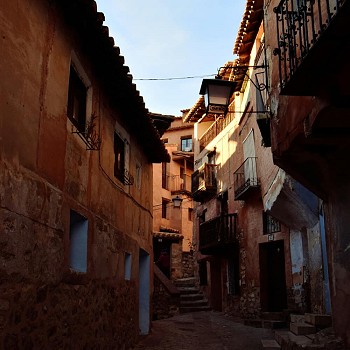
Alcaniz (bouldering) and Chullila (sport) are about two hours away, Benidorm (sport) three hours, Margalef (sport) three and a half hours, and La Pedriza (bouldering, sport, trad) 4 hours, making Albarracin a worthwhile stop on a more extensive road trip.
climbing, Albarracin is a beautiful medieval city that blends European and Arab influences. It is worth taking a walk through its narrow streets, seeing the Cathedral and making it up to the walls above the city (just follow the streets going up in the direction of the walls). Spanish Health and Safety procedures clearly aren't thought out along the same lines as those back home though - a couple of signs forbid climbing on the upper parts of the walls, but the Spanish don't seem to mind and most that make the walk up also get on the walls. Guided visits are available from many of the tourist shops in the old town if you are looking for a more in-depth history lesson.
Outside town, the Sierra de Albarracin and the Pinares del Rodeno are wonderful areas for anything from a short walk/run to a long hike. In the later signs will guide you around three different loops of 2-3kms around the forest and the prehistoric paintings.
Top tips for Albarracin
Learn a little Spanish – This one is true for most trips abroad, but worth repeating. Many locals speak very little English. A few words to say hi, ask for directions and order food and drink will go a long way to making your stay more enjoyable!
Check signs in car parks – Check car park signs and ask in sofa boulder for access updates. It's easy to miss them, but the information panels are usually kept up to date and are quite useful.
Try the bakery – There is a bakery and a couple of small shops that sell bread in Albarracin. Though Spain's reputation in the domain doesn't quite match up to neighbouring France, the bread and treats are worth the detour!
Have some Pan con Tomate – This typical Spanish breakfast is simply a slice of toasted bread covered in crushed tomatoes. It comes topped with local ham or cheese, or is simply enjoyed with olive oil and salt. Simple and delicious!
Logistics
When to Go
As usual, Spring and Autumn are the popular climbing seasons, but climbing is possible in Winter (it snows lightly some years) and in Summer.
How to Get There
Most people from the UK will fly to Madrid and rent a car. Zaragoza and Valencia are closer but there are less flights to these airports and/or they are normally more expensive.
Accommodation Advertise here
No Premier Listings found in this area
There are several accommodations available in town, mostly affordable hotels. Sandstone guesthouse is a popular choice with climbers and rents pads. Apartments with kitchens are available if you prefer to eat in some nights (Cine Capicol generally offers good value for money). The town is mostly car free but there is plenty of free parking at the entrance of town.
There is a campsite, Camping Ciudad de Albarracin, just outside town, which has tent spots and bungalows for hire.
If you travel in a van there are two car parks where 24hr parking is authorised, 'La Escombrera', half way between town and the boulders, and 'Centre de Interpretacion de Donarque', 10km from the boulders in the opposite direction from town. The car parks just outside of town and near the boulders themselves are strictly forbidden to overnight parking.
What's the food like?
There are lots of restaurants, from cheap pizzerias to Spanish tapas bars. Pizzeria Monty is good choice for cheap grub, Alcazaba is a great little restaurant run by a passionate local who is happy to make suggestions (as often in the area vegetarian options are limited but here at least they are interesting). There are a couple of small food shops but no major supermarkets. There are also a few stores selling local speciality cheese and ham. Teruel, 40min way, is where you'll find the closest supermarkets.
Outdoor Shops
Advertise here
No Premier Listings found in this area
There is a small climbing shop, Sofa boulder, on the outskirts of town, which also does pad rentals.
Guidebook
- Albarracin Bouldering and Bezas (2019)
- Albarracin Bouldering Guidebook (2014) by Roberto Palmer.
- Boulder Albarracin (2012) by Jorge Ferrando Monterde, David Moreno Gimeno and Tomás Segura Pretel of NoRop.es - published by Desnivel - The most popular and possibly most accurate guidebook.
- The old EBloc guide to bouldering in Spain also included a section on Albarracin, but is now out of print.
Instructor/Guides Advertise here
No Premier Listings found in this area

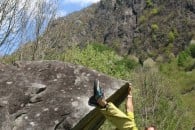

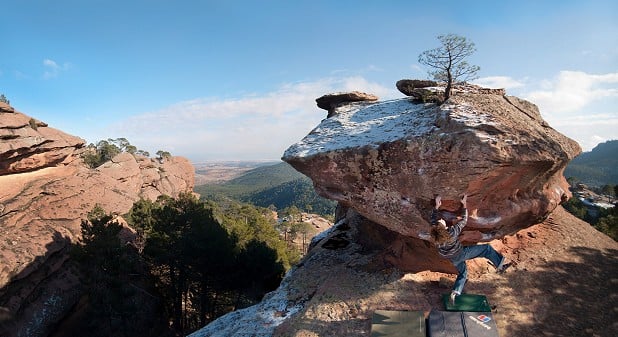

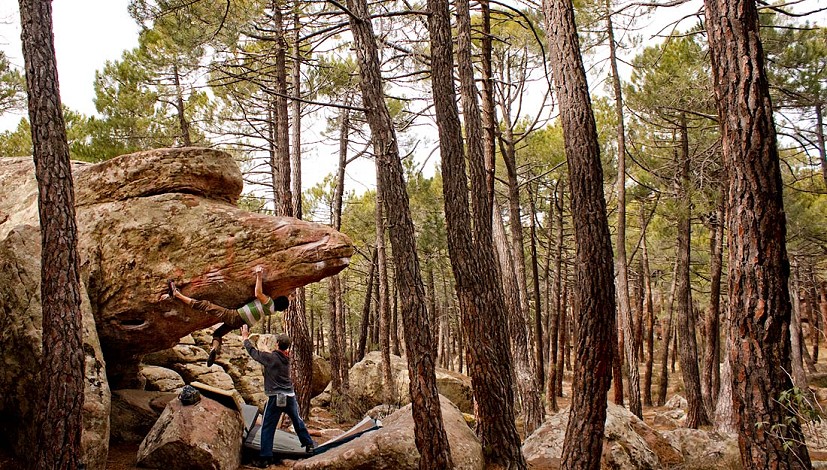
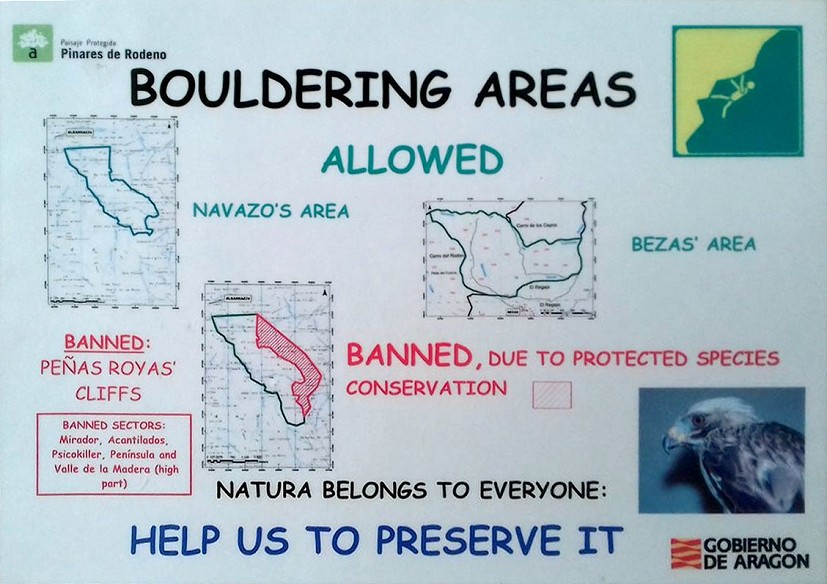
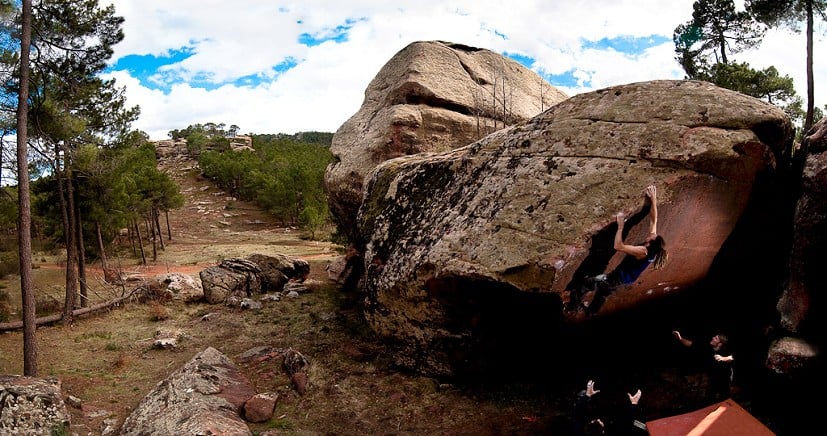
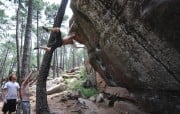

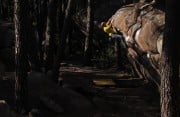
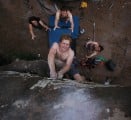
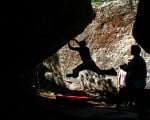


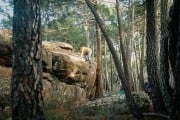
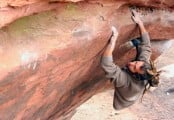



Comments
Nice write up. What’s the name of the highball 7c+ in the photos?
It's Homo ergaster (stand) (ARR-B60-L3) (f7C+)
It's always been a place of interest to me, but it's reputation as being a large open-air toilet, as well as generally a fine example of how not to treat the great outdoors really puts me off...
Is it as bad as people say?
I’d say no. Bushes around Bas Cuvier have generally been far worse than What even the busiest places in Alba have been.
I quite like it, especially around Xmas/New Years, when its generally still too cold in ’Bleau.
Oh, and 27Crags has good topos (also for Alcaniz). But same holds True for ’Bleau also.
I don't think so either. I was last there 18 months ago ago didn't notice any bad toilet behaviour.
The rock and problem quality is great. I don't think it'd hold up as well as Font sandstone given the same amount of traffic but I can't see that happening any time soon.